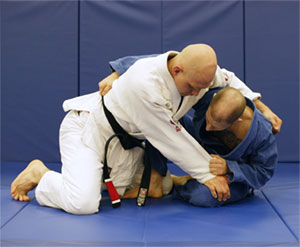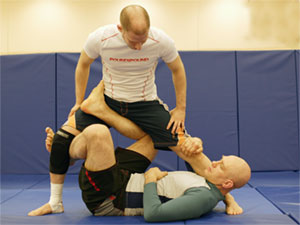
Underhooks in the butterfly guard postion are super important!
I was on a popular BJJ forum this afternoon when a thread about one of my favorite BJJ positions – the butterfly guard – caught my eye.
 As it turns out, someone was having problems. Here’s what he said:
As it turns out, someone was having problems. Here’s what he said:
“In the last few months I have really been concentrating on trying to get a solid butterfly guard. I bought Kesting’s Butterfly and X Guard DVD (which is excellent) and have been working on it every class. While I definitely feel that my butterfly is getting better, I am still having a very hard time establishing the guard.
What I mean by that is that if I can get one of the good butterfly positions (for me they are: 1) an underhook and an overhook, and 2) double underhooks). I can work some sweeps and pass prevention pretty well from there.
The problem is that I have a very hard getting into these positions and it’s quite frustrating. It seems that while I fight for those clinches my opponent will generally just grab my pants (I only do gi BJJ) and runaround or just push me down and flatten me out.”
Now I feel this guy’s pain, because these are legitimate problems. I struggled with the exact same concerns myself for a long time until I found some answers.
 The thing is, after you’ve swept a training partner with the ‘basic’ butterfly guard sweep10 times in a row he’ll figure out that you want the single or double underhooks. Then he’ll make it his mission in life NOT to give those positions to you.
The thing is, after you’ve swept a training partner with the ‘basic’ butterfly guard sweep10 times in a row he’ll figure out that you want the single or double underhooks. Then he’ll make it his mission in life NOT to give those positions to you.
Usually this means that he’ll back up, and that’s when he starts grabbing for your legs.
Letting your opponent control your pant legs in the butterfly guard is nota good idea. If he does this then you have to stop everything and strip his grip off of your pants RIGHT NOW (unless you’re setting him up with specific advanced sweeps).
Now on to the solutions…
If you’re fighting with the gi, then sometimes you can attack with the same basic sweep using an overhook, especially if your overhooking arm also grips his cross lapel to keep everything tight. I hear that Jean-Jacques Machadois very good at this.But if you can’t get close enough to grip then the armdrag is a great help. If he’s pushing you away then he’s giving you the arm to attack. And if you’re always armdragging him then he usually stops pushing you…
 Another strategy that works is to use one arm to stiffarm his neck/collar bone area. This is long range butterfly guard with a stiffarm is basically what some people call the “Sitting Guard” (click for a description).
Another strategy that works is to use one arm to stiffarm his neck/collar bone area. This is long range butterfly guard with a stiffarm is basically what some people call the “Sitting Guard” (click for a description).
One good attack from here involves gently pulling with the gripping hand, and then – suddently– changing directions, pushing forward with that hand while grabbing his heel with the other hand.
Another great technique involves pushing slightly with the stiffarming hand, waiting until you feel resistance, and then yanking him forward. You pull him down to the ground while shifting your hips out to the side.When you get the timing for this move right he just falls on his face and then you can scramble and get on top.
 Just watch out for flying armbar and triangle attacks when you’re using the stiff arm long range butterfly guard!
Just watch out for flying armbar and triangle attacks when you’re using the stiff arm long range butterfly guard!
I also REALLY like mixing up my butterfly guard with the X guard, both vs. standing and kneeling opponents.If you’re not using the X guard then you’re really limiting the power and versatility of the butterfly guard.
And here’s one final ideaI often like starting in ANOTHER position with the underhook already secured and then moving into the butterfly guard.
 One excellent position to do this from is the half butterfly guard. Start there, pushing your opponent away with your butterfly hook (or move your hips away) and end up in the butterfly guard.All the while you’ve maintained your underhook while moving everything else into position. And when your legs finally get there – boom – you’re ready to sweep him!
One excellent position to do this from is the half butterfly guard. Start there, pushing your opponent away with your butterfly hook (or move your hips away) and end up in the butterfly guard.All the while you’ve maintained your underhook while moving everything else into position. And when your legs finally get there – boom – you’re ready to sweep him!
The funny thing about all of this is that if you’re attacking your opponent with armdrags, stiff arms, heel picks, etc. then he’ll often give you the opportunity to get the underhook (or underhooks) that you wanted so much in the first place…


